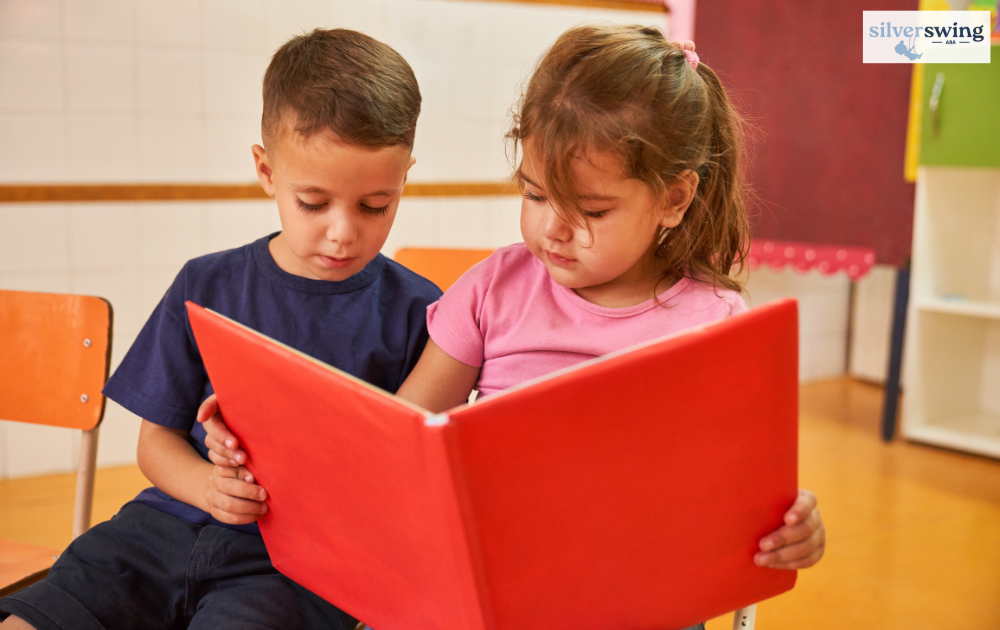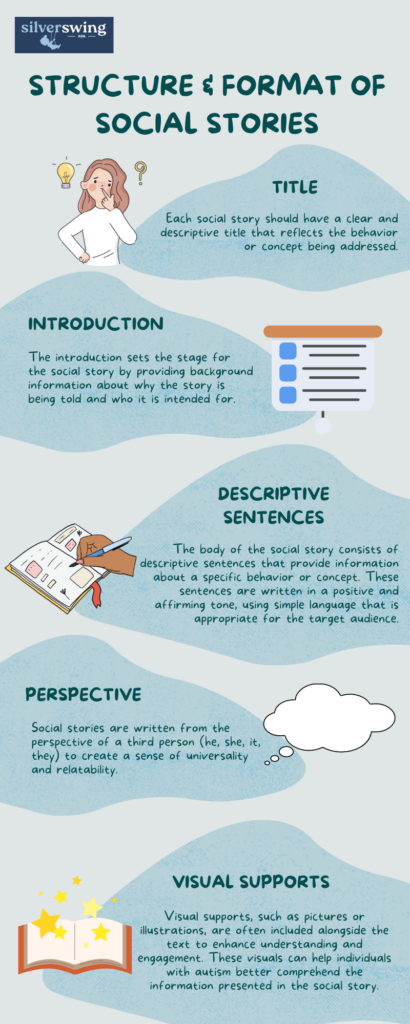To truly grasp the power and impact of social stories, it is important to delve into their origins, their benefits for autistic children, and the positive effects they can have on social interaction and behavior.
The Origins of Social Stories
Social stories were developed in 1991 by Carol Gray, a teacher working with young autistic children. Gray recognized the need for a tool that could effectively communicate social information to individuals with autism spectrum conditions (ASC) and other special educational needs (SEN). She invented social stories as a means to exchange information in a meaningful and understandable way between parents, professionals, and children with SEN.

How Social Stories Help Autistic Children
Social stories are written narratives accompanied by pictures that illustrate specific situations, problems, and challenges. They serve as a valuable resource for children (and adults) with autism spectrum conditions, other special educational needs, and children with anxieties. By using social stories, individuals can better understand social norms and learn how to communicate with others appropriately.
For autistic children, social stories play a crucial role in helping them navigate and comprehend social behavior in specific settings. Whether it’s a trip to the supermarket, a visit to the doctor’s office, or an outing to the playground, social stories can be created for almost any social situation. These stories provide a clear and structured framework for understanding the expectations and behaviors associated with different scenarios.
Benefits of Social Stories
Research has shown that social stories can have a positive impact on the behavior of autistic children. While they may be more effective at helping children manage their behavior rather than teaching specific social skills, social stories can significantly contribute to overall social development. By providing visual supports and clear explanations, social stories help children with autism better understand social situations, cope with challenges, and interact with others in a more appropriate manner.
Some of the key benefits of social stories include:
- Increased understanding of social norms and expectations
- Enhanced communication skills
- Improved ability to manage anxiety and cope with unfamiliar situations
- Development of appropriate behavior and social interaction skills
- Promotion of self-regulation and emotional well-being
Through social stories, parents, caregivers, and ABA professionals can effectively support autistic children in their social development journey, promoting greater independence and success in navigating the complexities of the social world.
In the next sections, let’s explore the components of effective social stories, different delivery methods, and practical tips for writing and implementing social stories.
Creating Effective Social Stories
When it comes to creating effective social stories, it can be helpful to seek professional guidance. Professionals such as psychologists and speech pathologists can provide valuable insights and teach you how to write social stories specifically tailored to your child’s needs. They can also advise you on the best delivery methods for the stories, whether it’s through reading them aloud, creating videos, or having your child read them independently.
Writing style and delivery methods play a crucial role in the effectiveness of social stories. The language used should be simple, concise, and easy for the child to understand. It’s important to use positive language and focus on desired behaviors or concepts rather than emphasizing negative behaviors.
Visual supports, such as pictures or illustrations, can enhance comprehension and engagement, especially for children with autism who may have a preference for visual learning. Incorporating visuals into the social stories can help reinforce the messages and make them more relatable.
Cost considerations and resources are also important factors to take into account. The good news is that anyone who has received proper training can write social stories, which means the cost can be quite low. Additionally, Medicare may cover the costs of seeing therapists like speech pathologists for up to 20 sessions, which can be beneficial for obtaining guidance and assistance with developing social stories.
To ensure the effectiveness of social stories, it’s important to keep certain key elements in mind. Each social story should address only one behavior or concept at a time, allowing for focused learning and understanding. The stories should be specific, providing clear explanations and examples that are relevant to the child’s daily life and experiences.
Here are a few examples of social story sentences:
- “When I feel angry, I can take deep breaths to help calm myself down.”
- “At school, it’s important to raise my hand and wait for the teacher to call on me before speaking.”
- “When someone is talking to me, it’s important to listen and make eye contact to show that I am paying attention.”
Implementing social stories successfully involves using best practices. Consistency is key, so incorporating social stories into daily routines and providing regular reinforcement can help reinforce the desired behaviors and concepts. It can also be helpful to involve the child in the process by allowing them to provide input or create their own social stories, fostering a sense of ownership and engagement.
By utilizing professional guidance, employing appropriate writing style and delivery methods, and considering cost and available resources, you can create effective social stories that support your child’s understanding of social norms and facilitate their communication skills.

Components of Social Stories
Social stories are powerful tools that help individuals with autism spectrum conditions (ASC), special educational needs, and anxieties understand social norms and develop appropriate communication skills. To effectively create and utilize social stories, it’s important to understand their key components. This section will explore the structure and format of social stories, the use of visuals, and how to address specific behaviors and concepts.
Structure and Format of Social Stories
Social stories are typically written in a specific format to ensure clarity and consistency. They consist of several key elements:

Visuals in Social Stories
The inclusion of visuals is an essential component of social stories. Pictures or illustrations help individuals with autism process and understand the information more effectively. Visual supports provide a concrete representation of the behavior or concept being addressed, making it easier for individuals to comprehend and remember.
When selecting visuals for social stories, it’s important to choose age-appropriate and culturally sensitive images. Clear and uncluttered visuals that accurately depict the behavior or concept are most effective. These visuals can be hand-drawn, photographs, or even symbols, depending on the individual’s preferences and needs.
Addressing Specific Behaviors and Concepts
Social stories are designed to address specific behaviors and concepts that individuals may struggle with. Each social story should focus on one behavior or concept at a time to avoid overwhelming the reader. By targeting specific behaviors or concepts, social stories can provide clear and concise information that is easy to understand and implement.
When addressing behaviors or concepts in social stories, it’s important to be specific and provide clear instructions or explanations. For example, a social story about maintaining personal hygiene may include step-by-step instructions on how to brush teeth or take a bath. By breaking down complex behaviors into manageable steps, individuals with autism can better understand and follow the desired behavior.
Social stories can be utilized in various settings, including home, school, and other environments, to support individuals in understanding and navigating social rules. By tailoring the content of social stories to specific behaviors and concepts, individuals with autism can develop the necessary skills to interact with others effectively.
Using Social Stories in Various Settings
Social stories are versatile tools that can be used in a wide range of settings to help children struggling to understand social rules and react appropriately. Whether at home, school, or in other environments, social stories can provide valuable support and guidance.
Let’s explore how social stories can be used in different settings.
Home-Based Applications of Social Stories
In a home setting, social stories can be a powerful tool for parents and caregivers to help children with autism navigate everyday situations. Parents can write social stories in various forms, with the most common being a social story that combines text with pictures targeting specific behaviors or concepts. Another effective approach is using a social script, which is a flipbook of responses to specific situations.
Social stories at home can address a wide range of topics, such as daily routines, hygiene practices, mealtime behavior, and social interactions with siblings or friends. By presenting information in a structured and visual format, social stories help children understand expectations, learn appropriate behavior, and reduce anxiety in unfamiliar situations.

School-Based Applications of Social Stories
In a school setting, social stories can be integrated into the curriculum and individualized education plans (IEPs) to support students with autism. Teachers, special education professionals, and school psychologists can collaborate to create and implement social stories tailored to each student’s needs.
School-based social stories can cover topics like classroom rules, transitions between activities, socializing with peers, and coping with sensory overload. By incorporating social stories into the classroom routine, educators can reinforce positive behavior, teach social skills, and promote inclusion.
Additionally, social stories can be used to facilitate peer understanding and acceptance of classmates with autism. Sharing social stories with classmates can foster empathy, reduce stigma, and create a supportive learning environment for all students.
Other Environments and Situations
Beyond the home and school settings, social stories can be applied in various other environments to assist children with autism. For example, social stories can be beneficial during community outings, visits to healthcare providers, or participation in extracurricular activities.
By using social stories in these settings, children with autism can gain familiarity with new places, understand expected behaviors, and feel more confident in navigating different social situations. Social stories can also help individuals with autism communicate their needs and preferences to others, promoting better understanding and support from the community.
Remember, social stories should be personalized to fit the specific needs and abilities of each child. It’s important to involve the child in the creation process, using their own experiences and interests to make the stories relatable and engaging. By utilizing social stories effectively in various settings, parents, caregivers, and ABA professionals can help children with autism improve their social interactions and navigate unfamiliar life situations.
Research on the Effectiveness of Social Stories
To fully understand the power of social stories, it is important to examine the research conducted on their effectiveness. Numerous studies have been conducted to explore the impact of social stories on individuals, particularly autistic children. The results consistently highlight the positive outcomes and improved social interaction associated with the use of social stories.
Studies on the Impact of Social Stories
Research in the field of applied behavior analysis (ABA) has shown that social stories can have significant positive effects on the behavior of autistic children. These stories are particularly effective in helping children manage their behavior, as they provide a structured and visual approach to learning and understanding social situations. While social stories may not be as effective in teaching specific social skills, they have demonstrated success in supporting behavior management.
Moreover, social stories contribute to the development of self-regulation skills in autistic individuals. These stories help individuals recognize and manage their own emotions, responses, and behaviors in various social situations. By promoting self-awareness and self-control, social stories empower individuals with autism to navigate social interactions more effectively.
The research on the effectiveness of social stories emphasizes their value as a visual support tool within ABA therapy. By incorporating social stories into the intervention strategies for autistic individuals, parents, caregivers, and ABA professionals can provide valuable support for social learning and development.

Best Practices for Successful Implementation
Implementing social stories effectively can greatly benefit children with special needs. Consider the following best practices when using social stories:
- Individualization: Tailor each social story to the unique needs and abilities of the child. Personalize the content to make it more relatable and relevant to their experiences.
- Repetition and Reinforcement: Regularly review and reinforce the content of social stories. Repeat the stories frequently to help the child internalize the desired behaviors or concepts.
- Consistency: Ensure consistency in the messaging and expectations across different environments and individuals involved in the child’s life. This helps to reinforce the lessons learned from the social stories.
- Gradual Progression: Introduce social stories gradually, starting with simpler concepts and behaviors before moving on to more complex ones. This allows the child to build a foundation of understanding and gradually develop more advanced social skills.
Social stories are powerful tools that facilitate social learning and communication, particularly for individuals with autism. By providing clear, concise, and tailored narratives, social stories help to demystify social situations, promote appropriate behaviors, and reduce anxiety. Their structured format enables users to better understand expectations and navigate various social scenarios with increased confidence and independence.




